
Rapport Spécial - Mission FAO/PAM d'évaluation des récoltes et de la sécurité alimentaire à Madagascar - 22 décembre 2017
22/12/2017
À la demande du Gouvernement de Madagascar, une mission conjointe FAO/PAM d'évaluation des récoltes et de la sécurité alimentaire (CFSAM) s'est rendue dans le pays du 24 juillet au 11 août 2017, à la suite des chocs météorologiques qui ont nui à la campagne agricole 2016/17. La Mission avait pour mandat de s’enquérir des facteurs ayant eu une incidence sur la production agricole, d'établir des estimations de la production céréalière nationale et d’évaluer la situation globale de la sécurité alimentaire et nutritionnelle. La Mission a bénéficié de l'appui technique et logistique de la Direction des systèmes d'information (DSI) du Ministère auprès de la Présidence en charge de l'agriculture et de l'élevage.
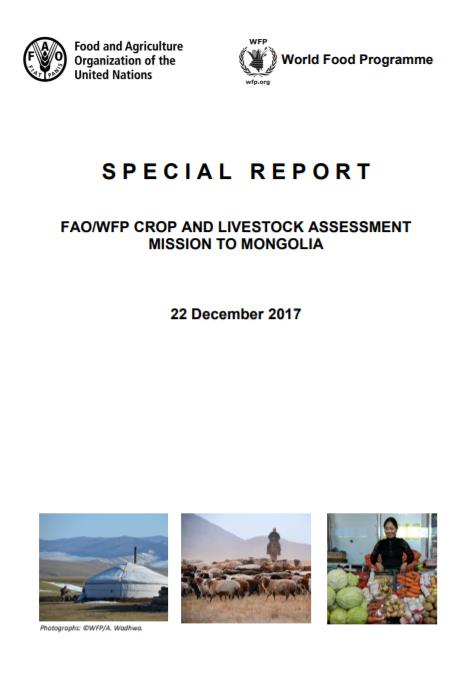
Special Report - FAO/WFP Crop and Livestock Assessment Mission to Mongolia
22/12/2017
An FAO/WFP Crop and Livestock Assessment Mission visited Mongolia from 15 to 28 October 2017, prompted by the prolonged drought from mid-May to end-July that sharply reduced the 2017 crop output and depleted rangeland conditions, raising serious concerns over the impact on the livestock ahead of the winter/spring period. The Mission estimated the impact of the dry weather on the 2017 wheat, potatoes and vegetable production and forecast the expected wheat deficit for 2017/18 marketing year (October/September). The Mission assessed also the impact of the dry weather on hay production and fodder supplies for the livestock sector for the forthcoming winter/spring months, up to April 2018. Furthermore, the mission assessed the impact of the drought on households, their coping strategies and contingency plans in view of the coming winter.
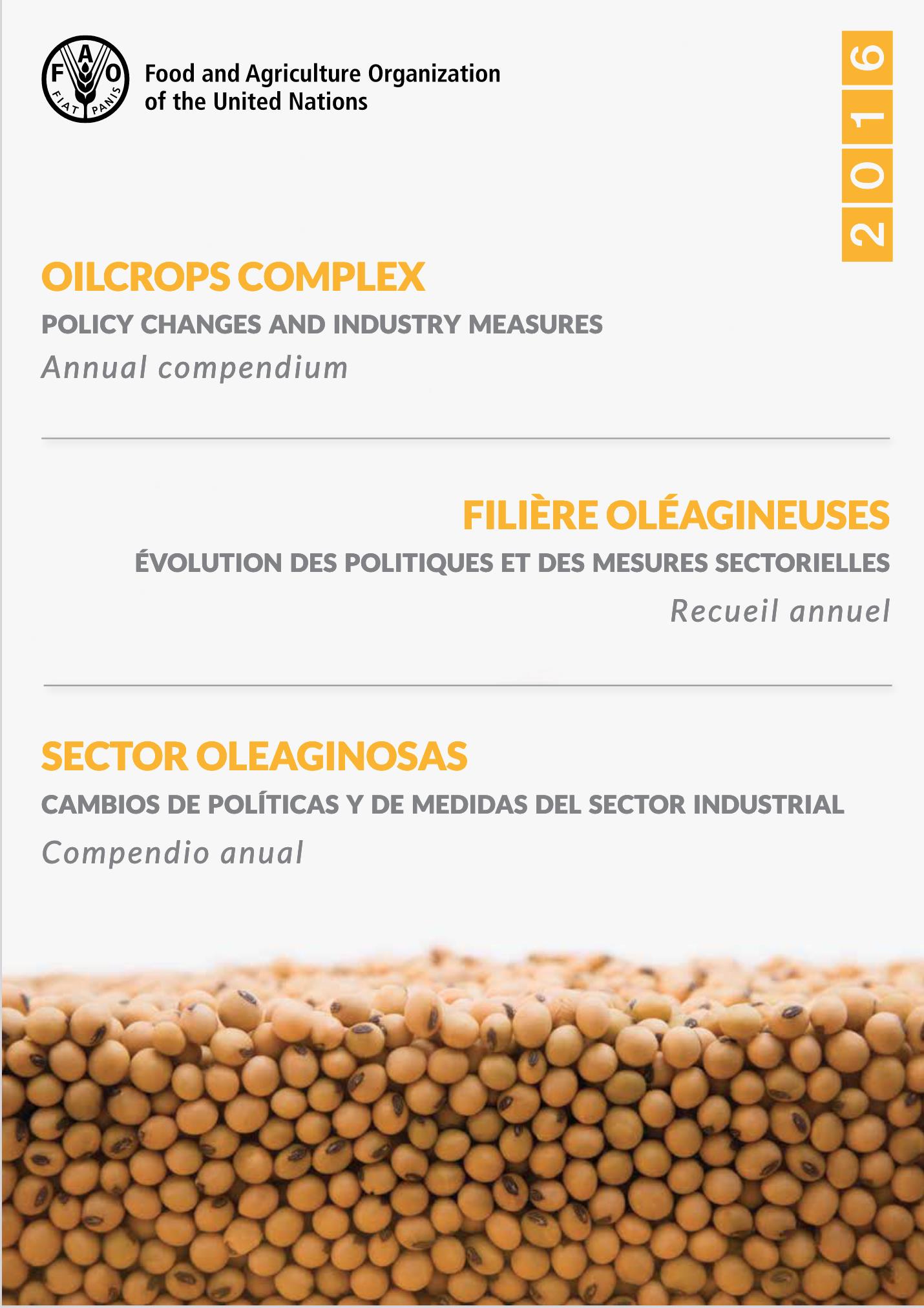
Oilcrops complex: policy changes and industry measures - Annual compendium - 2016
15/12/2017
The 2016 compendium offers an overview of salient government policies and related private sector measures concerning global and national markets for oilcrops and derived products. Its purpose is to facilitate the work of policy makers, market experts, analysts and other interested stakeholders by providing a short, concise overview of policy developments relevant to the sector. Detailed news items are presented in tabular form (in English only), preceeded by a brief discussion of the key policy trends observed in the year under review.
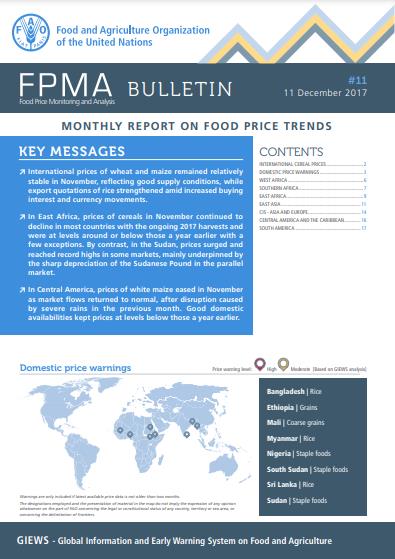
Food Price Monitoring and Analysis (FPMA) Bulletin #11, 11 December 2017
11/12/2017
International prices of wheat and maize remained relatively stable in November, reflecting good supply conditions, while export quotations of rice strengthened amid increased buying interest and currency movements. In East Africa, prices of cereals in November continued to decline in most countries with the ongoing 2017 harvests and were at levels around or below those a year earlier with a few exceptions. By contrast, in the Sudan, prices surged and reached record highs in some markets, mainly underpinned by the sharp depreciation of the Sudanese Pound in the parallel market. In Central America, prices of white maize eased in November as market flows returned to normal, after disruption caused by severe rains in the previous month. Good domestic availabilities kept prices at levels below those a year earlier.
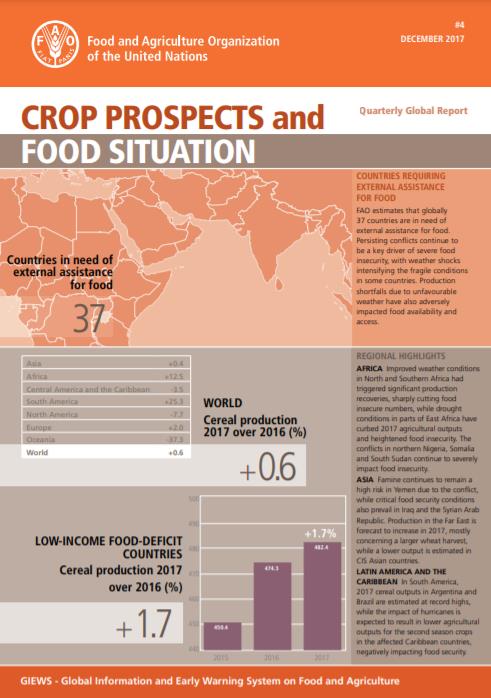
Crop Prospects and Food Situation - Quarterly Global Report, No. 4, December 2017
07/12/2017
FAO estimates that globally 37 countries are in need of external assistance for food. Persisting conflicts continue to be a key driver of severe food insecurity, with weather shocks intensifying the fragile conditions in some countries. Production shortfalls due to unfavourable weather have also adversely impacted food availability and access.
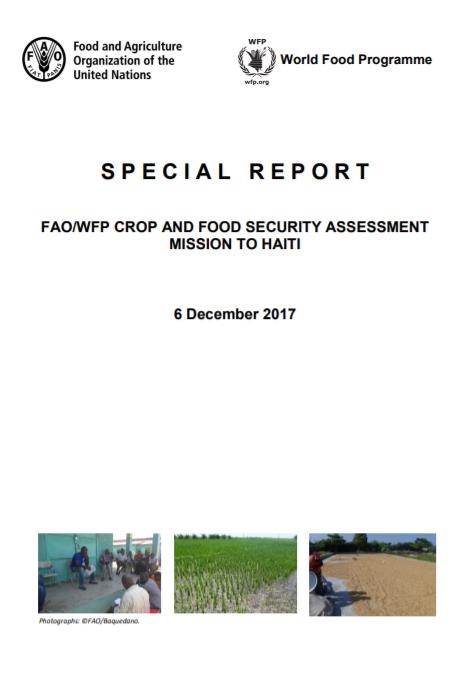
Special Report - FAO/WFP Crop and Food Security Assessment Mission to Haiti
06/12/2017
An FAO/WFP Crop and Food Security Assessment Mission (CFSAM) visited the country from 2 to 26 August 2017 to estimate food production for the 2017 spring season, which goes from March to August, and assess the food security situation. The spring season represents some 60 percent of the annual cereal output and is very important in determining food availability and food security during the upcoming 2017/18 agricultural year. The Mission was comprised of staff from FAO, WFP and the Ministry of Agr iculture, Natural Resources and Rural Development of Haiti (MARNDR) which was represented by the National Coordination for Food Security of Haiti (CNSA) and the Agricultural Statistics and Informatics Unit (USAI). Staff from the Famine Early Warning Systems Network (FEWSNET) and the European Union’s Joint Research Centre (JRC) collaborated closely with the Mission as observers.
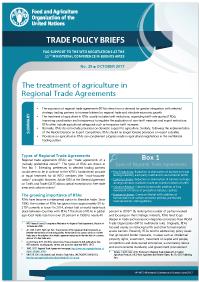
No. 29 The treatment of agriculture in Regional Trade Agreements
05/12/2017
A discussion on the growing importance of Regional Trade Agreements (RTAs) and the trends in the treatment of agriculture in RTAs.
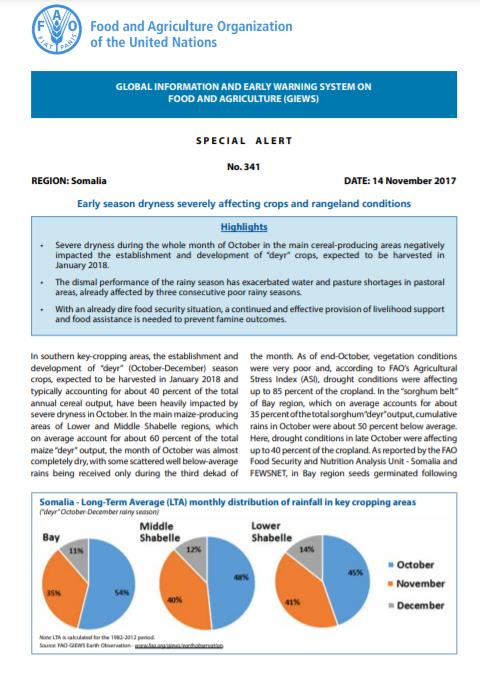
GIEWS Special Alert No. 341 - Somalia, 14 November 2017
14/11/2017
Severe dryness during the whole month of October in the main cereal-producing areas negatively impacted the establishment and development of “deyr” crops, expected to be harvested in January 2018. The dismal performance of the rainy season has exacerbated water and pasture shortages in pastoral areas, already affected by three consecutive poor rainy seasons. With an already dire food security situation, a continued and effective provision of livelihood support and food assistance is needed to prevent famine outcomes.
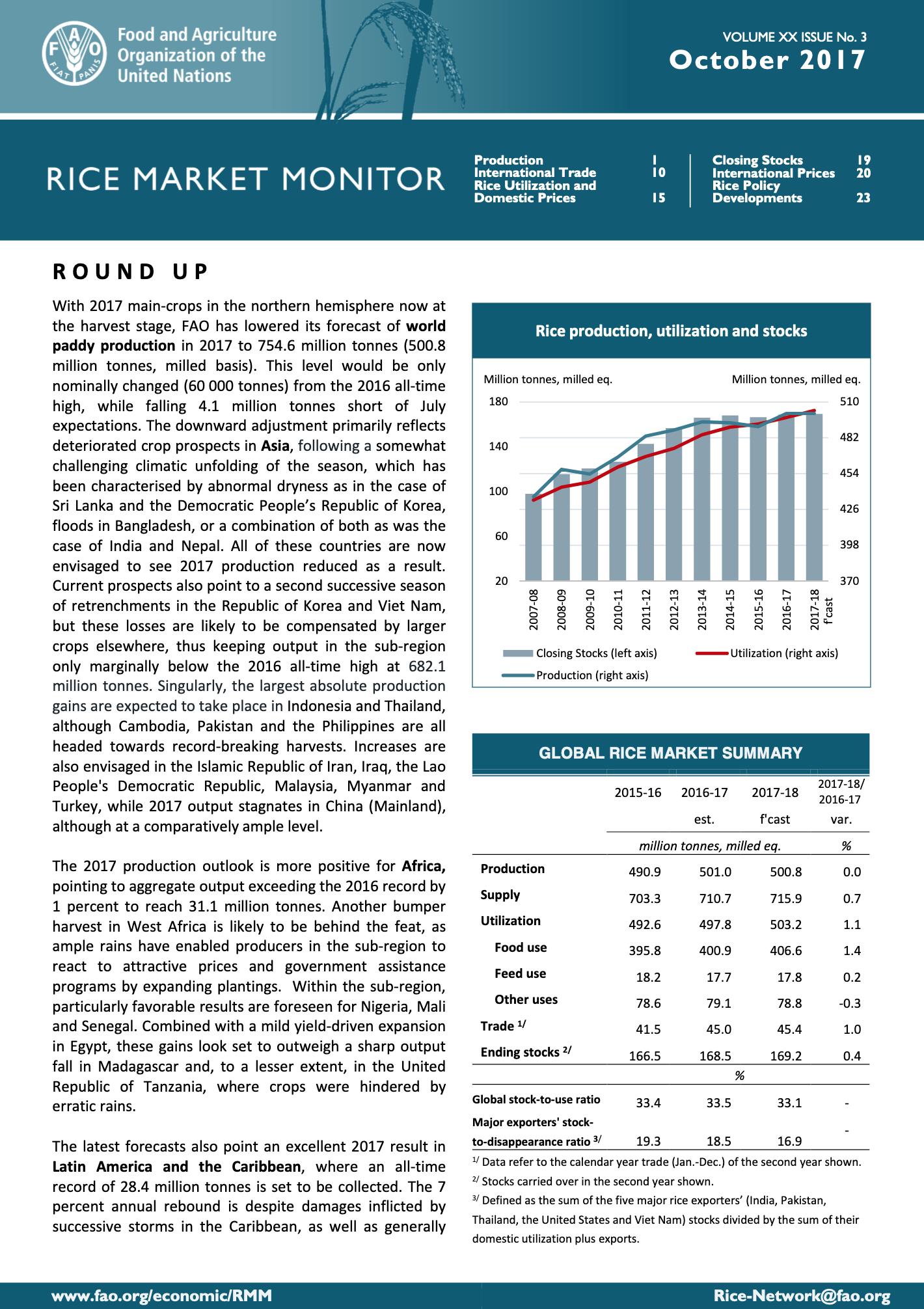
FAO Rice Market Monitor - October 2017
10/11/2017
The October 2017 issue of the FAO Rice Market Monitor (RMM) provides analysis and forecasts of world rice production, utilization, and global rice inventories in 2017/18 season. It also covers the outlook of world trade in rice in calendar year 2017 and 2018, as well as a review of international rice prices during the past quarter.
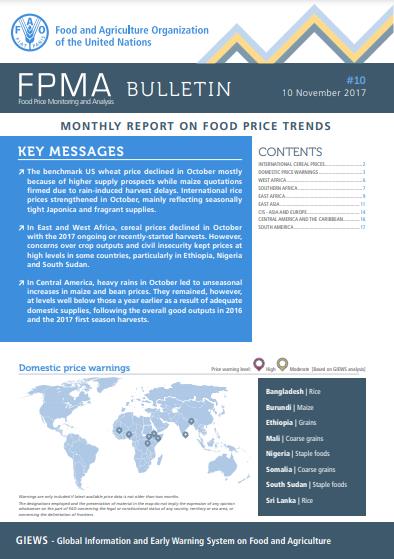
Food Price Monitoring and Analysis (FPMA) Bulletin #10, 10 November 2017
10/11/2017
The benchmark US wheat price declined in October mostly because of higher supply prospects while maize quotations firmed due to rain-induced harvest delays. International rice prices strengthened in October, mainly reflecting seasonally tight Japonica and fragrant supplies. In East and West Africa, cereal prices declined in October with the 2017 ongoing or recently-started harvests. However, concerns over crop outputs and civil insecurity kept prices at high levels in some countries, particularly in Ethiopia, Nigeria and South Sudan. In Central America, heavy rains in October led to unseasonal increases in maize and bean prices. They remained, however, at levels well below those a year earlier as a result of adequate domestic supplies, following the overall good outputs in 2016 and the 2017 first season harvests.
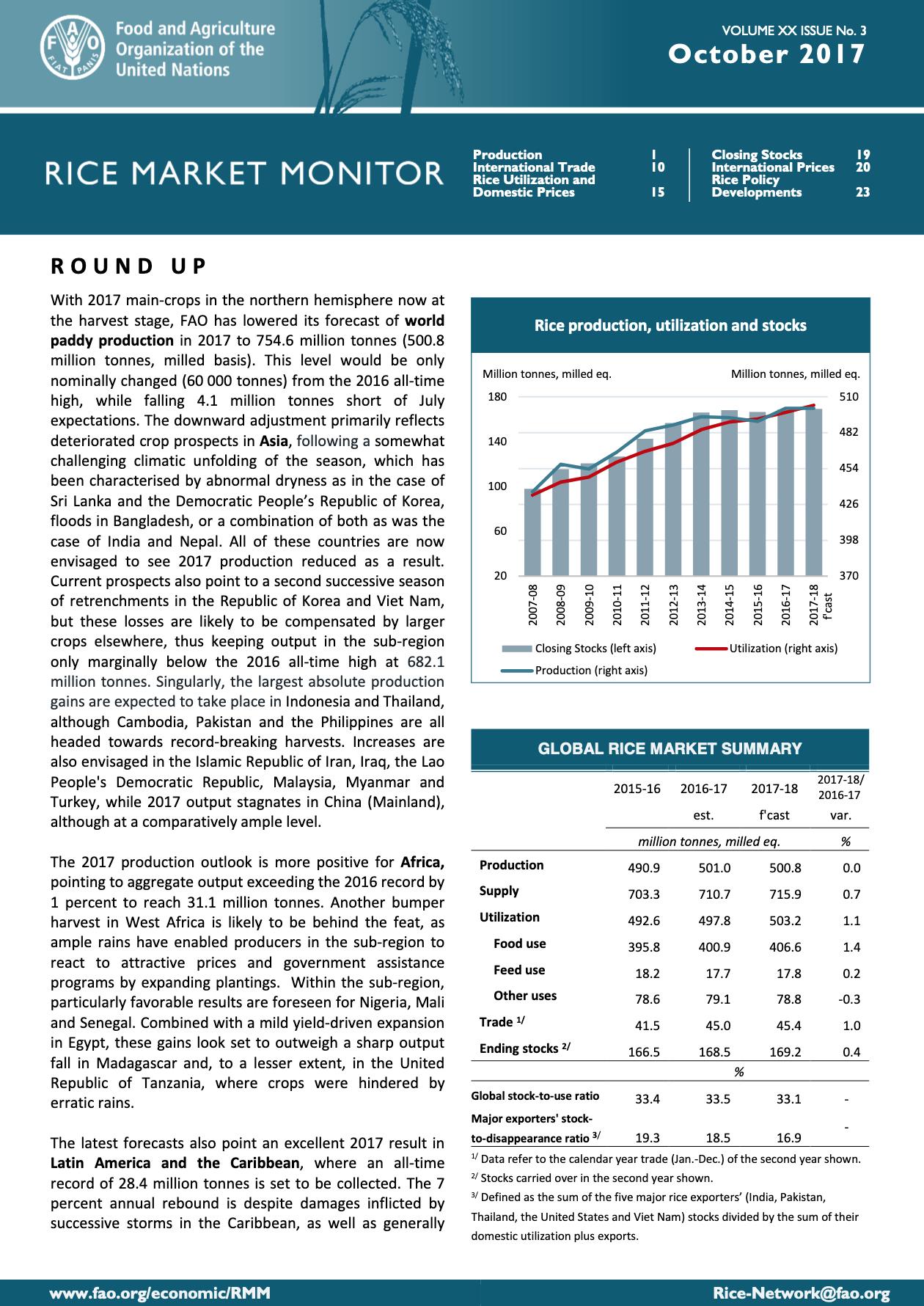
FAO Rice Market Monitor - December 2017
10/11/2017
The October 2017 issue of the FAO Rice Market Monitor (RMM) provides analysis and forecasts of world rice production, utilization, and global rice inventories in 2017/18 season. It also covers the outlook of world trade in rice in calendar year 2017 and 2018, as well as a review of international rice prices during the past quarter.
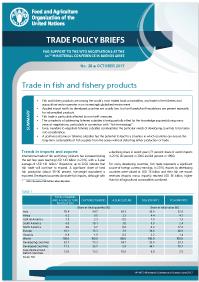
No. 28 Trade in Fish and Fishery Products
07/11/2017
This brief discusses trade in fish and fishery products, in particular, trends in import and export, subsidies, tariff and non-tariff measures.
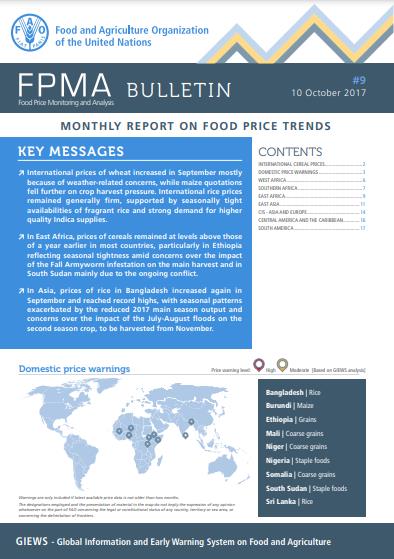
Food Price Monitoring and Analysis (FPMA) Bulletin #9, 10 October 2017
10/10/2017
International prices of wheat increased in September mostly because of weather-related concerns, while maize quotations fell further on crop harvest pressure. International rice prices remained generally firm, supported by seasonally tight availabilities of fragrant rice and strong demand for higher quality Indica supplies. In East Africa, prices of cereals remained at levels above those of a year earlier in most countries, particularly in Ethiopia reflecting seasonal tightness amid concerns over the impact of the Fall Armyworm infestation on the main harvest and in South Sudan mainly due to the ongoing conflict. In Asia, prices of rice in Bangladesh increased again in September and reached record highs, with seasonal patterns exacerbated by the reduced 2017 main season output and concerns over the impact of the July-August floods on the second season crop, to be harvested from November.
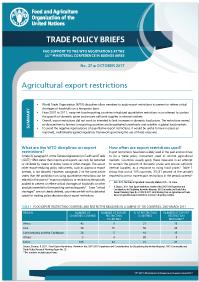
No. 27 Export restrictions in agriculture trade
10/10/2017
This brief explains and explores the rationale and options for strengthening disciplines on export restrictions.
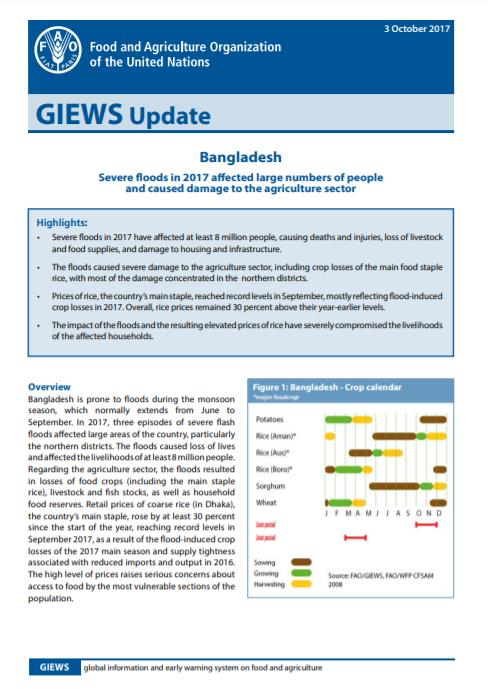
GIEWS Update - Bangladesh, 3 October 2017
03/10/2017
Severe floods in 2017 have affected at least 8 million people, causing deaths and injuries, loss of livestock and food supplies, and damage to housing and infrastructure. The floods caused severe damage to the agriculture sector, including crop losses of the main food staple rice, with most of the damage concentrated in the northern districts. Prices of rice, the country’s main staple, reached record levels in September, mostly reflecting flood-induced crop losses in 2017.
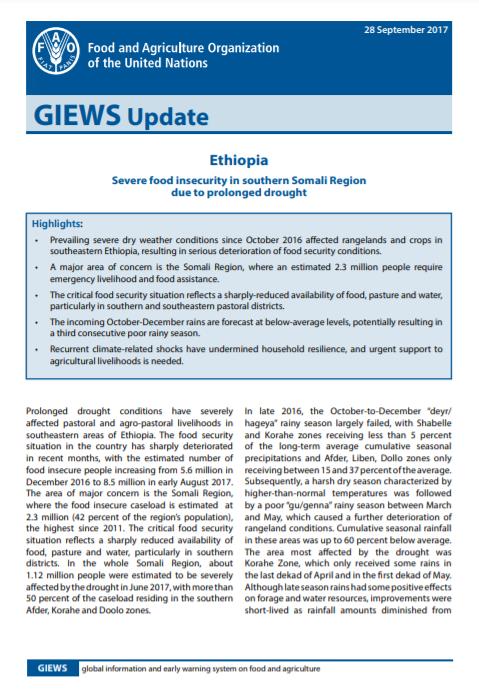
GIEWS Update - Ethiopia, 28 September 2017
28/09/2017
Prevailing severe dry weather conditions since October 2016 affected rangelands and crops in southeastern Ethiopia, resulting in serious deterioration of food security conditions. A major area of concern is the Somali Region, where an estimated 2.3 million people require emergency livelihood and food assistance. The critical food security situation reflects a sharply-reduced availability of food, pasture and water, particularly in southern and southeastern pastoral districts.
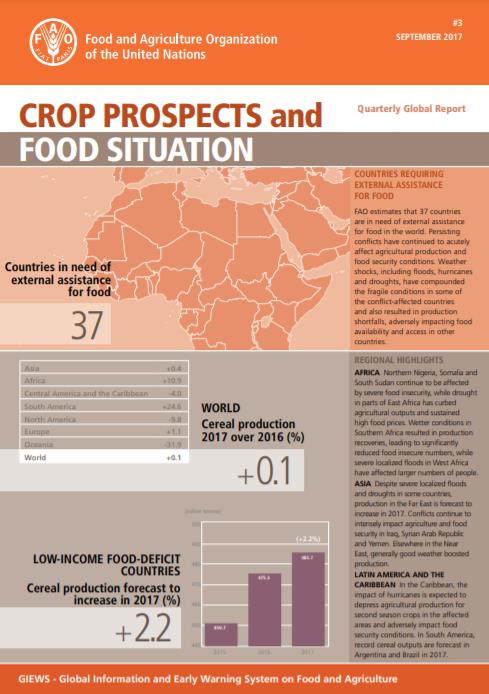
Crop Prospects and Food Situation - Quarterly Global Report, No. 3, September 2017
21/09/2017
FAO estimates that 37 countries are in need of external assistance for food in the world. Persisting conflicts have continued to acutely affect agricultural production and food security conditions. Weather shocks, including floods, hurricanes and droughts, have compounded the fragile conditions in some of the conflict-affected countries and also resulted in production shortfalls, adversely impacting food availability and access in other countries.



